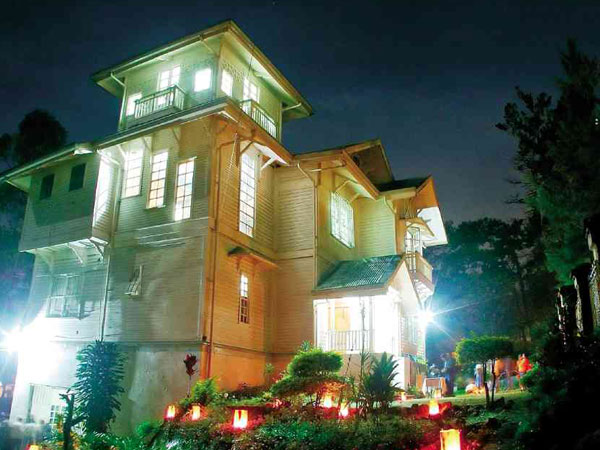Signs of the spirits in ‘White House’

HAUNTED? The old Laperal house near Teachers’ Camp in Baguio City has become a popular photo backdrop for tourists on All Saints’ Day, which is observed Friday, Nov. 1. RICHARD BALONGLONG/INQUIRER NORTHERN LUZON
BAGUIO CITY—Nathaniel Hawthorne’s Gothic novel “The House of the Seven Gables” tackled ancient guilt and was inspired by his ancestors’ participation in the Salem witch trials of 1692, with the 17th-century Pyncheon house as the center of the story.
On Leonard Wood Road here, the imposing Laperal mansion is Baguio City’s answer to the Pyncheon house. The mansion, known here as the “White House,” has its share of tales of cruelty and horror.
Lito Calvo, the house’s gardener for 14 years, is familiar with the ghost stories passed on by “Ate Lina,” a helper and a longtime caretaker employed by Roberto Laperal, who built the house in the 1930s.
Calvo, 48, said Lina had told him the house was taken by Japanese soldiers from the Laperal family during World War II. The rooms and sections of the house were witnesses to the cruelty of the Japanese soldiers, he said.
“This is the place where so many killings happened when Japanese soldiers lived here, that’s why it has always been believed that the ghosts of the past still haunt this house,” Calvo said.
Alma Ramos, 37, the house’s caretaker for 10 years, believes the occupants were living with spirits.
“The women were raped in the bedrooms, Filipino men who were accused of spying for the Americans were interrogated in the sala, then they were tortured and killed. There was even a house help who committed suicide here,” Ramos said.
Restless spirits
She said a visitor, presumably with a third eye, had told her that restless spirits lived in the house.
“I was told the spirits were strongly felt in the master bedroom and in another bedroom,” she said.
Ramos and Calvo said they had observed signs that the spirits were around.
“The lights would switch off and on, and there were times that people who were passing by would see images moving by the windows,” Calvo said.
Ramos said she heard strange footsteps from the stable in the basement and the sound of doors and windows being shuttered, even when there was no one around.
She said a security guard and taxi drivers had told her they had seen an apparition of a “woman in white” going into and leaving the house.
“The guard saw the [woman in white] enter through the gate and walk toward his direction in the porch, where he was resting. He also said the [apparition] walked over him and entered through the main door that was closed,” she said.
She said several taxi drivers had told her they were afraid to pass by that section of Leonard Wood Road during late hours because they might see apparitions in the house.
“Oftentimes, they honked their horns as they passed in front of the house, perhaps as a way of excusing themselves [to the spirits],” she said.
Moving things
Ramos said the spirits were too strong and might have overpowered her 8-year-old son, who, a spiritist had told her, had a “third eye.”
“I had a novena held for my son so his third eye would be closed. I believe the energy of the spirits was draining his strength because he was often sick,” she said.
But the spirits made themselves felt during the novena.
“The candles and the flowers moved from one room to another, and no one among us had transferred them,” Ramos said.
The Laperal house is Victorian, a style associated with affluence and extravagance.
According to the book “Istilo,” a pocket guide to architecture styles in the Philippines that was published by the National Commission for Culture and the Arts this year, Victorian houses are narrow and tall, and have steep roofs, bay windows and stairs at the front door.
It also features wooden planks, gables (the triangular upper part of a wall closing the end of a pitched roof) and dormers (windows projecting from the slope of the roof).
Original wood
The Laperal house, built on a 4-hectare property near Teachers’ Camp, still keeps its original yakal and narra wood.
The receiving room has a fireplace and old furniture, while the main living room has been turned into an exhibit area for bamboo carvings. The dining area retains the old narra dining table.
The house has a narrow staircase leading to the four rooms on the second floor. The master bedroom has a fireplace and a terrace.
A narrow staircase leads to the view deck.
The latest décor displayed in the house is a skullcap that Calvo found in March when he was digging in the garden. It sits on a windowsill by the staircase.
Calvo said a former worker in the house found gold and silver coins underneath the fireplace in the receiving room. The worker, he said, kept the coins.
According to Calvo and Ramos, a businessman now owns the property. The businessman bought it from one of the biggest realty companies in the country.
Open to public
The Laperal house was opened to the public in November last year after the Asin Bamboo Carvers Guild Inc. had used it for exhibitions.
For a fee of P50, visitors can see the exhibit and tour the house.
“This is an important structure in Baguio. It stood the test of time—it survived World War II and even the July 1990 earthquake. People will always notice this house,” Ramos said.














